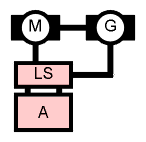
text
 |
Probably, some inventors were inspired by this little experiment which is called electric wheel. If this wheel is exposed to a static electric field of high voltage, it starts to rotate. Although this is caused by static electricity, this does not imply that the device runs for free. |
Electrostatic machines and effects based on static electricity were the first which were studied by researchers. Otto von Guericke became famous not only by his air pressure demonstrations, but also by his invention of a first electrostatic generator, which was made of a rotating sulphur sphere and a leather cushion pressed onto its surface.
First machines to generate electricity produced it by electrostatic effects. Inventors worth mentioning are Hauksbee, Winkler, Holtz and Wimshurst, whose machine concepts proved to be the most successful. Even today, there are efforts to combine a variant of the Wimshurst machine whith other electric components in order to produce overunity behaviour. The history section provides a history of electrostatic machines in a nutshell.
Electrodynamic generators are based on the combination of electric and magnetic effects.
One particular device always is mentioned, if the discussion focuses on electrostatic perpetual motion machines: The Thestatika Machine. Its basic element is an electrostatic generator whose principle is the same of the Wimshurst machine.
The classic electrodynamic PMM is based on a motor and a generator. We have seen this image already in the concepts section:

Although a comparatively modern technology is used, this is a sort of recirculation mill, which is known since centuries. There are direct analogies between the operating principles. Unfortunately, the analogies also include the energy losses, which makes this type of machine as unworkable as the mills based on aqua morta. What efficiency can we expect of an electric system likes this? The answer can easily be found by opening the loop at a suitable point and studying the open chain of components.
yyy
It is worth a consideration why electrodynamic machines are based on moving parts. Mechanically moved parts always need bearings and the losses by transforming electric power into mechanic power should be avoided as possible. Consequently, there are machine designs which claim to produce overunity behaviour by using transformer-like or gyrator-like principles.
| Last update: 27 October 2003 / |
|